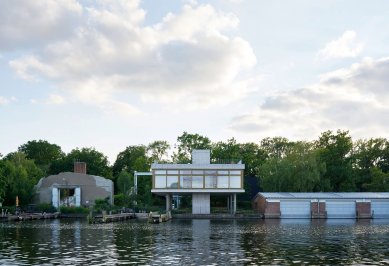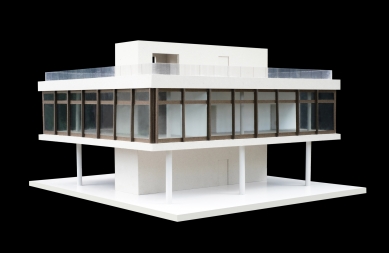
p420
Haus an der Spree

New construction of a residential building on the former shipyard grounds of the GDR’s water police, which retains the free view onto the Spree and, in its materiality and appearance, blends naturally into the industrial surroundings of concrete footbridges, bank reinforcement and boathouses from the 1970s.
In interaction with the neighbouring ruined garden, through which the view of the Spree is deliberately staged, it was necessary to raise the building and thus provide a generous view of the water. To blend in with the character of the surroundings, the narrow lightweight concrete core, which runs through the centre of the building, was constructed with industrial panel formwork with no exposed concrete requirements, while the columns were constructed with a correspondingly raw wooden formwork. To avoid the arrangement of expansion joints, the upper parapet cornice is also made of lightweight concrete. In contrast to the narrow windowless core, the living level opens outwards all around. The elevated view of the water does not reveal a bank wall, so that the water seems to flow through underneath. The material presence of the glass façade with its anodised elements – also a reference to the 1970s – emphasises the physical appearance of the building. The skylight band optically binds both ceiling panels together, proportioning and giving the interior a human scale.
In order to disturb the longitudinal flow of the core as little as possible, the partition walls between staircase, kitchen and bathroom – all bundled in the core – are made of glass blocks. This typical element can also be found on some existing buildings, including the directly adjacent boathouse. Reversible furniture made of zebrano wood veneer zoning and dividing the living area. A long cupboard unit creates two bedrooms, the rear side of which is made of plastered clay panels to regulate the room climate. Opposite the core, a rule that can be played on two sides proportions the large living space and divides it into two areas that can be used differently. The side of the shelf facing the water resembles an oversized letterbox, which is filled with various objects.
The shape of the railing of the precast concrete staircase is modelled on the fall protection during the shell construction phase. The saw-rough wood, partly left with tree bark, comes from the trees that had to be felled for the construction of the building. This wood was used to design and manufacture other furniture for the house, such as the large dining table. The sofa as well as the curtains printed with a colour gradient are also objects that were designed together with artist Anselm Reyle.
In interaction with the neighbouring ruined garden, through which the view of the Spree is deliberately staged, it was necessary to raise the building and thus provide a generous view of the water. To blend in with the character of the surroundings, the narrow lightweight concrete core, which runs through the centre of the building, was constructed with industrial panel formwork with no exposed concrete requirements, while the columns were constructed with a correspondingly raw wooden formwork. To avoid the arrangement of expansion joints, the upper parapet cornice is also made of lightweight concrete. In contrast to the narrow windowless core, the living level opens outwards all around. The elevated view of the water does not reveal a bank wall, so that the water seems to flow through underneath. The material presence of the glass façade with its anodised elements – also a reference to the 1970s – emphasises the physical appearance of the building. The skylight band optically binds both ceiling panels together, proportioning and giving the interior a human scale.
In order to disturb the longitudinal flow of the core as little as possible, the partition walls between staircase, kitchen and bathroom – all bundled in the core – are made of glass blocks. This typical element can also be found on some existing buildings, including the directly adjacent boathouse. Reversible furniture made of zebrano wood veneer zoning and dividing the living area. A long cupboard unit creates two bedrooms, the rear side of which is made of plastered clay panels to regulate the room climate. Opposite the core, a rule that can be played on two sides proportions the large living space and divides it into two areas that can be used differently. The side of the shelf facing the water resembles an oversized letterbox, which is filled with various objects.
The shape of the railing of the precast concrete staircase is modelled on the fall protection during the shell construction phase. The saw-rough wood, partly left with tree bark, comes from the trees that had to be felled for the construction of the building. This wood was used to design and manufacture other furniture for the house, such as the large dining table. The sofa as well as the curtains printed with a colour gradient are also objects that were designed together with artist Anselm Reyle.
Tanja Lincke
0 comments
add comment



























